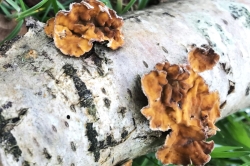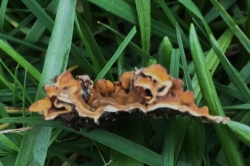One of the three native bleeding Stereum species. It is annual, often resupinate and mostly growing on the dead wood of Oaks.
Home / Mushroom Guide /
Bleeding Oak Crust
Bleeding Oak Crust
| Mushroom Type | |
| Common Names | Bleeding Oak Crust (EN), Crawen Waedlyd y Derw (CY), Skórnik Dębowy (PL), Nemezes Réteggomba (HU) |
| Scientific Name | Stereum gausapatum |
| Synonyms | Haematostereum gausapatum, Stereum quercinum, Stereum cristulatum |
| Season Start | All |
| Season End | All |
| Average Mushroom height (CM) | |
| Average Cap width (CM) | 1–4 |
Fruiting Body
This species might form fully resupinate or semi-pileate fruit bodies. Often grows in clusters, also often forms large tiers (when numerous fruit bodies are fused/overlapping).
1–4 cm wide, irregular, and broadly attaching to the substrate without having a stem.
Upper surface (skin) of the semi-pileate form is finely tomentose (woolly, velvety, or densely covered with fine hairs), becoming smooth with age. It is faintly concentrically zoned. Originally greyish to brownish. Margin is sharp, lobed, wavy, and paler than the upper surface.
Fertile surface is uneven to warty, buff to pale ochraceous brown, possibly with greyish marks on it. Staining bright red when cut or bruised.
Flesh
Thin, tough and elastic when moist, leathery and brittle when dry, whitish to buff, reddening when cut or bruised.
Habitat
Grows on dead wood of Oaks, and according to some authors, even on other hardwoods (but in that case microscopy is a must to confirm the suspected ID), regardless if the dead wood is still attached to the tree or already fallen. Saprotrophic, causes white-rot.
Possible Confusion
There are a three bleeding Stereum species in the UK.
Bleeding Broadleaf Crust (Stereum rugosum) grows on many different hardwoods, incl. Oak, Beech, Birch, Ash, Poplar, etc. It develops a new layer every year (so it is perennial, not annual as S. gausapatum), microscopy is a must to separate it from Bleeding Oak Crust (S. gausapatum) with confidence if found on Oak.
Bleeding Conifer Crust (Stereum sanguinolentum) grows on conifers, most of all Spruce.
Taste / Smell
Inedible. Taste and smell not distinctive.
Frequency
Very common and widespread in the UK.
Spores
Spore print is white. Spores narrowly ellipsoid, sub-cylindrical, smooth, colourless (hyaline) and very slightly amyloid (which proves the spore wall does contain starch in traces).




























Leave a Reply